Why does powdery mildew appear on cucumbers and why is it dangerous: photos and treatment, preventive measures
Powdery mildew is a fungal disease that affects cucumbers both outdoors and indoors. Spores spread quickly in conditions of high humidity and cool air. In this article we will talk about the causes of the disease, signs of infection, methods of treatment and prevention.
What is powdery mildew
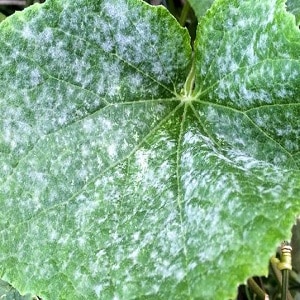 Powdery mildew, white, or ash - a disease of a fungal nature. It occurs as a result of infection of plants by microscopic ectoparasites. At the beginning of summer, whitish mycelium multiplies on the leaves and shoots, turning into drops of dew. That's why the disease got its name.
Powdery mildew, white, or ash - a disease of a fungal nature. It occurs as a result of infection of plants by microscopic ectoparasites. At the beginning of summer, whitish mycelium multiplies on the leaves and shoots, turning into drops of dew. That's why the disease got its name.
The pathogen lives in the top layer of soil, on the weeds. Therefore, the lower leaves are infected first. The infection then gradually spreads upward.
The fungus endures the winter and awakens in the springwhen the air becomes warm and humid. Spores are carried by wind and raindrops.
Danger to cucumbers
Due to its fungal nature, the disease thrives in moist conditions. Affected cucumber bushes lose their visual appeal and vitality. The growth and development of the plant is suspended.
The stems and leaves first wither, then dry out and die. Powdery mildew rarely affects fruits, but greens deprived of nutrition begin to turn black and rot.
Other cucumber diseases:
Mechanism and development cycles
Powdery mildew (Erysiphe graminis) affects living plant tissue. Spread occurs through the formation of conidia (non-motile, asexually reproducing spores) on the front side of the leaves.
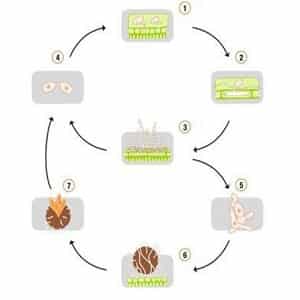 Spores actively form at temperatures air +18–20 °C and high humidity. Viable only for 2–4 days. On the fifth day of infection, new colonies of spores appear. During the drought period, the process of reproduction of conidia and further infection of plants is suspended.
Spores actively form at temperatures air +18–20 °C and high humidity. Viable only for 2–4 days. On the fifth day of infection, new colonies of spores appear. During the drought period, the process of reproduction of conidia and further infection of plants is suspended.
Life cycle of Erysiphe graminis:
- Germination of spores.
- Infection.
- Spondium chains.
- Spread of spores.
- Formation of male and female reproductive organs.
- Cleistothecia.
- Release of spores from a ruptured cleistothecia.
Symptoms of the lesion
Powdery mildew affects cucumbers in early June. It is during this period that the air temperature changes; rain replaces the heat.
The following signs indicate the disease::
- white or yellowish coating on leaves and stems;
- small brown balls (spores) on the plant;
- drops of dew on the leaves;
- dry, curled leaves;
- traces of rot on the fruit.
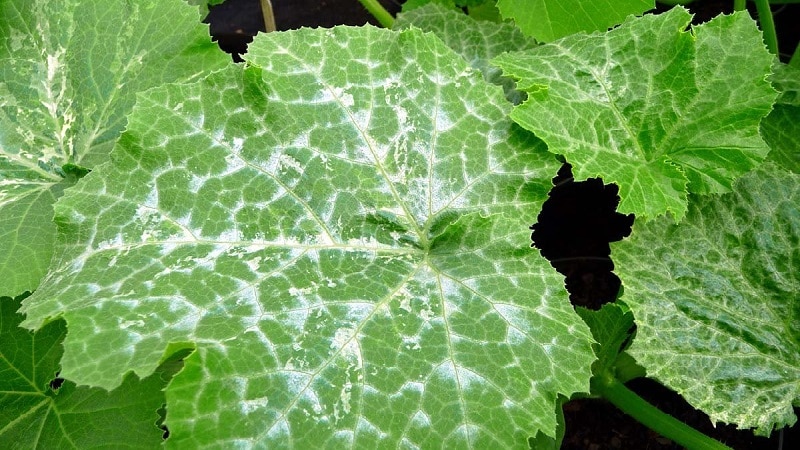
What do affected cucumbers look like?
White spots on the leaves initially occupy a small area. Over time, they grow, the leaves turn completely white, then turn gray and curl with the edges up.
If the disease is not treated, the plaque thickens and turns brown, spreads to the entire plant and affects cuttings, stems, ovaries, greens. The cucumbers look like they are covered in mold and are starting to rot. This is the last stage of the disease, which makes no sense to treat - unfortunately, the harvest cannot be saved.
How to distinguish from downy mildew
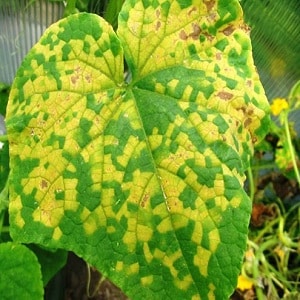 Powdery mildew is often confused with downy mildew, which is called peronosporosis. The disease has the following distinctive features:
Powdery mildew is often confused with downy mildew, which is called peronosporosis. The disease has the following distinctive features:
- a large number of small yellow spots appear on the leaves;
- the affected area increases within 5–7 days;
- the leaves turn brown and dry out.
Downy mildew affects plants at any stage of the growing season. It occurs due to high air humidity and watering cucumbers with cold water.
Causes of the disease
The main reason is infection of the vegetative parts of the plant by fungal microorganisms.
Powdery mildew affects cucumbers when:
- sudden changes in temperature;
- prolonged rains;
- watering with cold water;
- dense planting of plants;
- non-compliance with the rules of agricultural technology (weeding, weed removal, loosening the soil);
- lack of sunlight;
- excess nitrogen in the soil;
- lack of potassium and phosphorus.
Often fungus affects cucumbers in open ground. This is facilitated by drafts, heavy rains, wet soil, and temperature fluctuations.
Infection occurs in greenhouses as a result of ventilation and increased humidity. The first symptoms appear on bushes located near windows or doors.
In greenhouses, cucumbers become infected first, growing near poorly glazed frames or in cool and damp nooks.
Treatment methods
The most effective in combating powdery mildew on cucumbers are chemicals and folk methods based on fermented milk products, ash, manure, soda ash, soda and herbal infusions.
Folk remedies
Folk remedies used for preventive purposes or immediately after detection of the disease. In a situation where the fungus has covered a large area of cucumber plantings, traditional methods are powerless.
The best homemade remedies are considered:
- Curdled milk, whey, kefir. For 10 liters of water, take 1 liter of fermented milk product of your choice. Treat plants as often as required.
- Soda ash. For 1 liter of water, take a third of a teaspoon of soda and 25 ml of liquid soap. Treatment is carried out once a week.
- Wood ash. A liter jar of ash is poured with 5 liters of boiling water and left for 24 hours. The bushes are irrigated with the prepared liquid once a week.
- Cow dung. 1 kg of manure is diluted in 10 liters of water and left for 3 days. Then pass through a filter and dilute the solution with water 1:10. Watering is carried out in the evening to prevent sunburn.
- Horsetail decoction. For 10 liters of water take 1 kg of fresh or 100 g of dried raw materials. Leave for one day, then boil for 2 hours over low heat, filter and cool. Add water to the broth in a ratio of 1:5. Bushes are treated once a week.
- Infusion of marigolds. 0.5 buckets of flowers are poured with warm water, left for 48 hours, filtered and mixed with 50 g of any soap. Irrigate the bushes twice a week.
Important! Treatment with folk remedies begins during periods of prolonged rains and evening fogs.
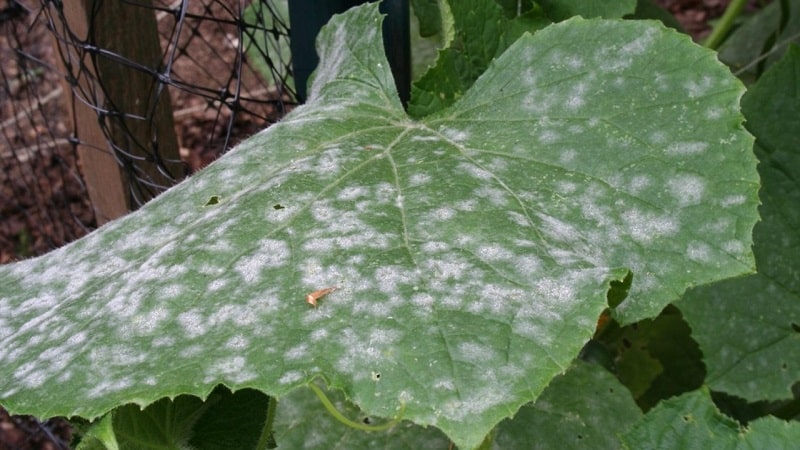
Chemicals
The best chemicals to combat powdery mildew on cucumbers:
- "Bayleton". The therapeutic effect on the treated bushes lasts up to a month in dry and sunny weather.
- "Raek". Begins to act 2 hours after spraying. The protection lasts for a week.
- "Tiovit Jet". Chemical with a protective effect – up to 7 days.
- "Topaz". Plant protection product for 1-2 weeks. Spray when the first symptoms of the disease appear and for the purpose of prevention. The first treatment is after the appearance of 8–10 true leaves, the second is at the beginning of flowering, 10 days after the first.
- Colloidal sulfur solution. For 10 liters of water take 40 g of the substance. Cucumbers are processed in cloudy weather.
- "Fundazol". 10 g of powder is dissolved in 10 liters of water and at least three treatments are carried out on the bushes at the rate of 1.5 liters per 10 square meters.m.
- "Skor". Systemic fungicide for the treatment and prevention of powdery mildew. 2 ml of the product is diluted in 10 liters of water. Consumption per plant – 1 liter. The treatment is carried out three times.
- "HOM". For 10 liters of water take 40 g of powder, 100 ml of low-fat milk. Consumption per 10 sq. m – 1 l. Spray cucumbers in the evening, in dry, windless weather.
Read also:
Why boric acid is useful for cucumbers and how to use it
Why do you need to treat cucumbers with brilliant green and how to do it
Prevention
Prevention methods will help protect cucumbers from powdery mildew infection:
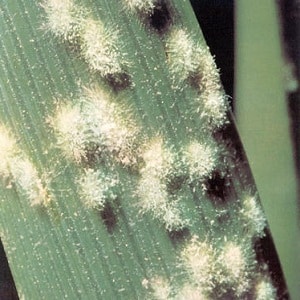 Cleaning up weeds and bushes with roots after harvest.
Cleaning up weeds and bushes with roots after harvest.- Soil treatment with biological agents (“Alirin-B”, “Gamair”).
- Disinfection of holes with a hot, strong solution of potassium permanganate before planting seedlings.
- Nitrogen level control. Its excess stimulates the proliferation of powdery mildew spores.
- Choose varieties and hybrids of cucumbers that are resistant to powdery mildew.
- Maintaining distance between seedlings when transferring to the ground.
- Preventive treatments with Fitosporin, Ordan, Kuprolux.
- Compliance with the principle of crop rotation and re-planting cucumbers in the same place no earlier than two years later.
- Planting seedlings in sunny areas without drafts.
- Fertilizing the soil with humus or compost.
- Thinning cucumber plantings.
Varieties and hybrids resistant to powdery mildew
There are many cucumber varieties and hybrids with immunity against the fungus Erysiphe graminis. We have selected a list of the best of them.
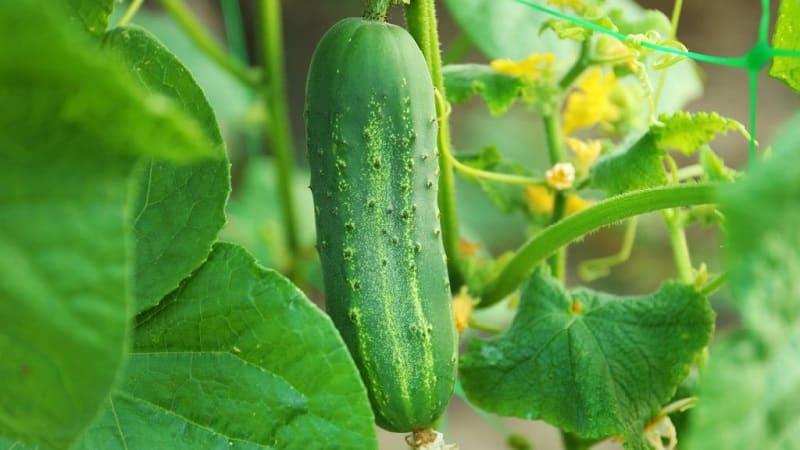
Competitor
Bee-pollinated high-yielding variety for open and closed ground.
| Ripening time | Fruit shape | Length | Weight | Skin | Pulp | Harvest from 1 m² |
| 43–55 days | Oval-round | 10–15 cm | 100 g | Dense, with black spines | Crispy | 3–5 kg |
Ant F1
Ultra-early hybrid for greenhouses.
| Ripening time | Fruit shape | Length | Weight | Skin | Pulp | Harvest from 1 m² |
| 35–40 days | Oval | 12 cm | 110 g | Medium density, with white edge | Crispy | 10–12 kg |
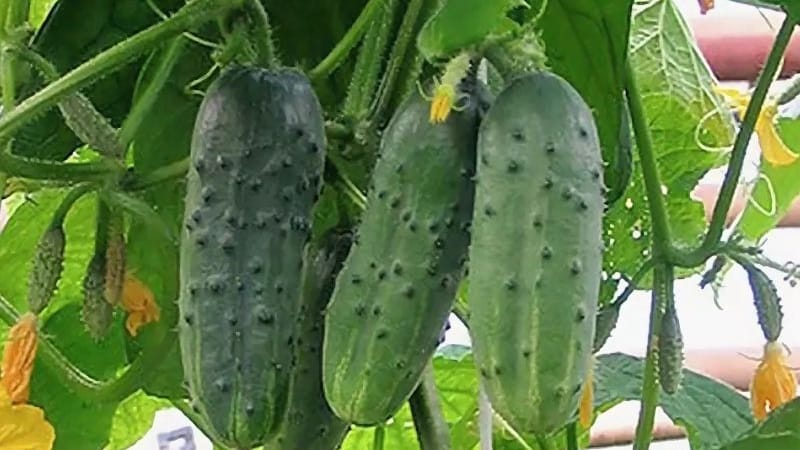
Masha F1
Ultra-early ripening self-pollinating hybrid for open and closed ground.
| Ripening time | Fruit shape | Length | Weight | Skin | Pulp | Harvest from 1 m² |
| 36–40 days | Cylindrical. | 9 cm | 90 g | Thick, with pubescence | Crispy, no bitterness | 10-11 kg |
Murashka F1
Early ripening hybrid Murashka for greenhouses, greenhouses, vegetable gardens.
| Ripening time | Fruit shape | Length | Weight | Skin | Pulp | Harvest from 1 m² |
| 42–45 days | Cylindrical. | 8–12 cm | 100 g | Dense, coarsely tuberculate, with black spines. | Doesn't taste bitter | 10–12 kg |
Thumb F1
Precocious parthenocarpic hybrid for closed ground.
| Ripening time | Fruit shape | Length | Weight | Skin | Pulp | Harvest from 1 m² |
| 39–42 days | Oval | 11 cm | 50–65 g | Dense, with small tubercles | Doesn't taste bitter | 10–13 kg |
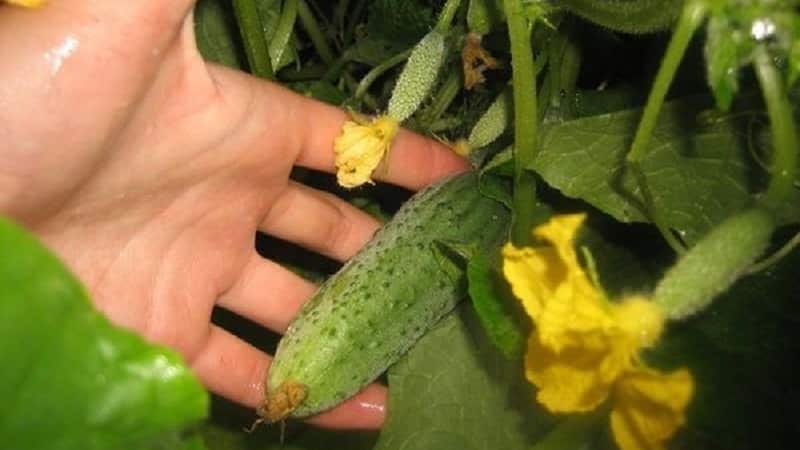
Benefit F1
Parthenocarpic hybrid for greenhouses and greenhouses.
| Ripening time | Fruit shape | Length | Weight | Skin | Pulp | Harvest from 1 m² |
| 45–50 days | Oval | 10–12 cm | 100–120 g | Dense. with small white spines. | Doesn't taste bitter | 11-12 kg |
Alekseich F1
Early ripening hybrid for greenhouse cultivation.
| Ripening time | Fruit shape | Length | Weight | Skin | Pulp | Harvest from 1 m² |
| 35–45 days. | Elongated cylindrical | 7-8 cm | 60–80 g | Medium density, with pubescence | It doesn't taste bitter. | 8–10 kg |
Swallow F1
Bee-pollinated early-ripening hybrid for open ground.
| Ripening time | Fruit shape | Length | Weight | Skin | Pulp | Harvest from 1 m² |
| 40–50 days | Oval | 12 cm | 85–115 g | Dense, with small tubercles and pubescence | Doesn't taste bitter | 15 kg |
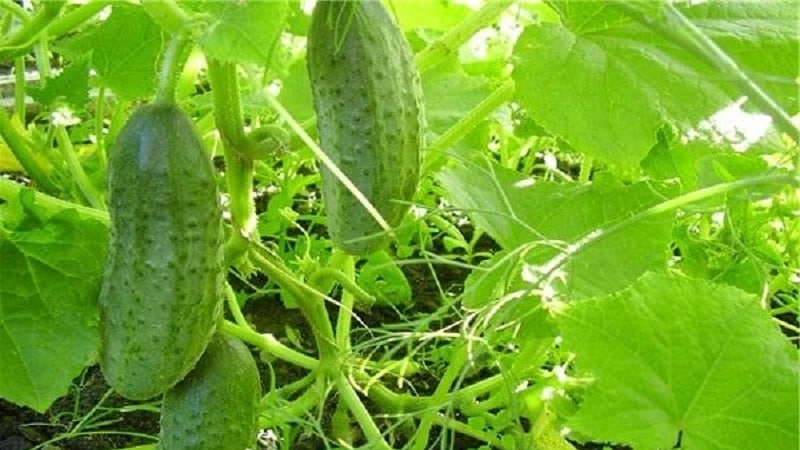
Artek F1
Early maturing bee-pollinated hybrid for open and closed ground.
| Ripening time | Fruit shape | Length | Weight | Skin | Pulp | Harvest from 1 m² |
| 40–42 days | Fusiform | 9 cm | 70–85 g | Dense, with small bumps and white pubescence | Crispy, not bitter | 10–12 kg |
Conclusion
Powdery mildew on cucumbers is a widespread fungal disease. High air humidity, temperature changes, excess moisture and nitrogen in the soil are factors that provoke infection and rapid progression of the disease.
Using cucumber varieties that are more resistant to the disease for growing will minimize the risk of powdery mildew infection. Compliance with crop rotation, watering rules and regular inspection of plants also contribute to prevention.
For treatment, chemicals and folk remedies with copper, soda, horsetail, marigold, and wood ash are used. Preventative measures will prevent infection or minimize damage.